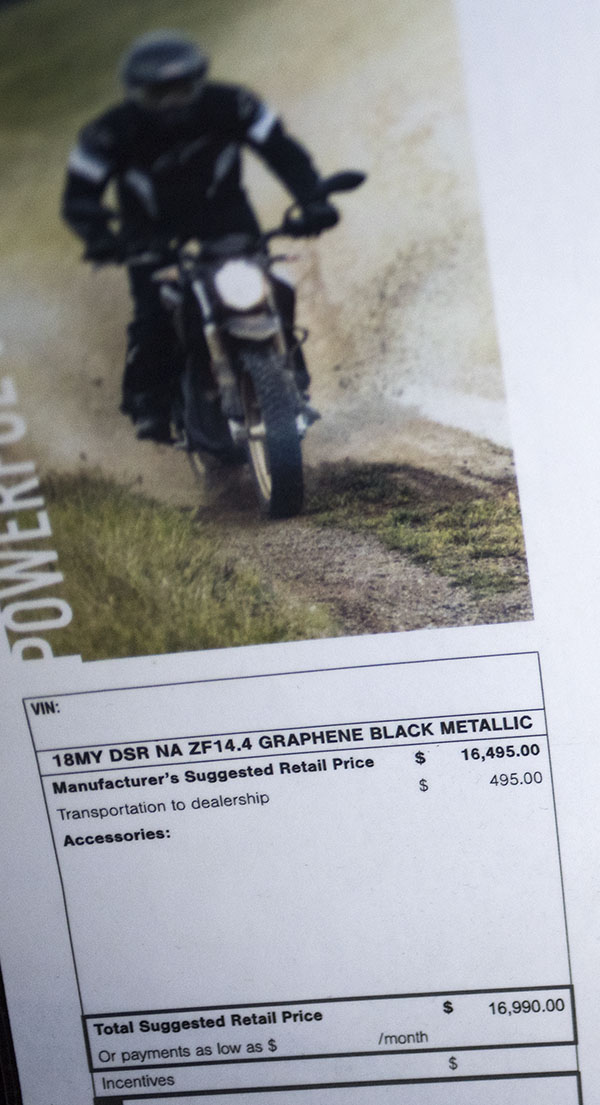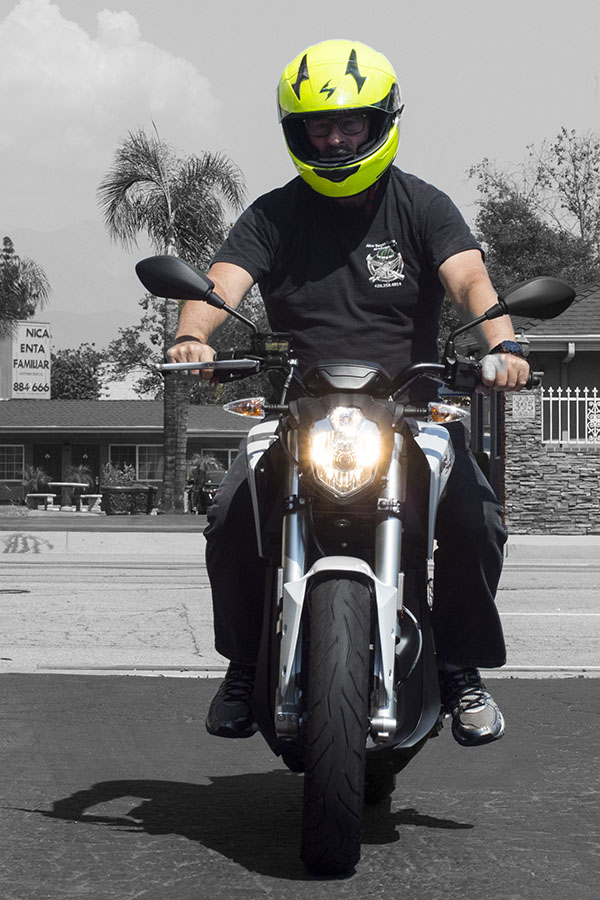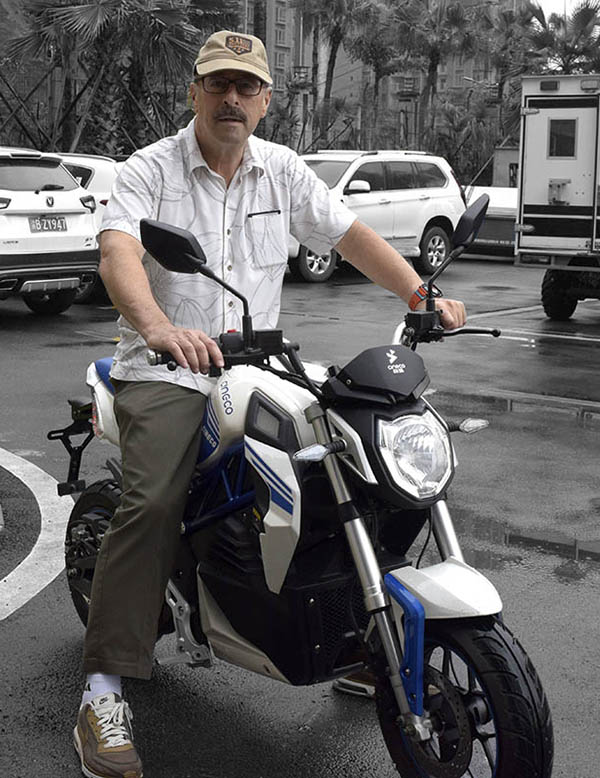This is an interesting thing to do…a comparison of two electric motorcycles, the Zero SR and the CSC City Slicker. Some of you might think I’m nuts for even attempting it. After all, the Zero costs $16,990, and the Slicker is $2,495. And that’s before you put all of the fees, taxes, and other stuff on either bike. You might predict I’m going to say one is overpriced and the other is cheap Chinese junk, but I’m not. These motorcycles are different tools intended to meet different needs for different riders. The good news is they’re both fun. A lot of fun, actually.

You might ask: Why just these two motorcycles? Aren’t there other e-bikes out there?
Well, yes and no. But that’s a subject for another blog and I’ll come back to that question later. I included only the City Slicker and the Zero because I had access to both. I have a relationship with CSC (I used to write the CSC blog and I’ve literally been all over the world on their bikes) and my good friend Art Guilfoil owns a Zero dealership (Douglas Motorcycles, in San Bernardino).
Zero has been around for a few years, and the SR is one of their latest models. It’s a refined design, and it is the state of the art in electric motorcycles. To cut to the chase, I was impressed (more on that in a bit).

The CSC City Slicker is new. I first rode one in China during a visit to Zongshen, and I recommended to CSC that they bring the City Slicker to North America. It’s working well; the City Slicker has received tremendous press here in the US and CSC sales of this new electric motorcycle are brisk.

I’m going to compare Slick and Zero from performance, price, and product perspectives. There’s too much going on to cover it all these topics in a single blog entry, so this comparison will be presented in several blogs. This first one is on two aspects of performance: Acceleration and top speed. There are other performance parameters, including range, recharge time, braking, and handling. I’ll cover those in a future blogs.
Acceleration
For starters, if you’re looking for 0-60 or ¼-mile times, read no further. I didn’t do any of that. The City Slicker won’t go 60 mph, and I didn’t take either bike to Irwindale. My comments on acceleration are subjective. With that caveat, let’s dive in to this topic.
I rode the Zero at Douglas Motorcycles in San Bernardino and I was impressed. I like it when a motorcycle accelerates so hard it scares the hell out of me, and the Zero did that. I’ve owned fast bikes before (a Suzuki TL1000S, and a Triumph Daytona and a Speed Triple). Those bikes had a direct connection from their throttles to the gland that releases adrenalin. The Zero, however, is in another league altogether. In the Sport Mode, the SR has a punch in the pants that is downright terrifying. Bottom line: I thought that was very cool. I liked it. A lot.
The City Slicker? The first time you ride one, it has a tendency to feel like it’s going to squirt out from under you, but you get used to it quickly. That’s what happened to me in China. Slick’s acceleration is more manageable. Slick had no problem keeping up with city traffic when the light turned green. It was a little weird accelerating in total silence. I could hear every sound from the cars and other bikes around me. It was different.
They tell me the torque is instantaneous off zero rpm with electric bikes. What that translates into is a punch the instant you twist the throttle. On the City Slicker, it’s there, but it’s not intimidating. It’s maybe a notch into the “wow” range the first time you ride the bike, and then it just becomes part of the experience. On the Zero, it’s simultaneously awesome, exciting, and terrifying. Folks, the Zero is one hard-accelerating motorcycle.
I mentioned the Sport mode on the Zero, so let me get into that now. Both bikes have rider-selectable operating modes. I’m an older guy and I always thought the idea of a “mode” was a silly thing when it first appeared on internal combustion bikes. In fact, a kid at one of the motorcycle shows once visited the CSC booth after spending time with the Ducati people and he wanted to know how many modes the CSC 250cc bikes had. At first, I didn’t know what he was talking about, and then I got it.
“Two,” I said. “On, and Off.”
That was then, and this is now. On electric bikes, these modes are good ideas. You need them to maximize range (the subject of a future blog), and in the case of the Zero, to keep the bike from getting away from you.
Zero has three modes: Eco, Sport, and Custom. The Eco mode dials down the bike’s acceleration and maximizes range. The Custom mode lets you use your smartphone to manage the bike’s power output, and you can dial in whatever you want between the bike’s Eco and Sport settings. The Sport mode is for balls out, no holds barred, raw power. It’s wicked.
Zero advertises that their bike will out-accelerate a Porsche 911. I didn’t have a chance to check that out, but I’ll take their word for it. I tried the Sport mode when I rode the Zero, and it is seriously fast. I was scared I would lose control of the rear wheel (the Zero has ABS but not traction control; they tell me that may change next year). Not much scares me; accelerating on a Zero in the Sport mode did. I like being scared. You probably will, too.
The City Slicker has two modes: Eco and Power. The Eco mode limits the bike’s top end to 36 mph, and it gives the bike a longer range. The Power mode removes the output limit, and lets the bike accelerate up to an indicated 46-47 mph. What’s cool is you can switch between modes on the move. If you’re rolling along at 35 mph in the Eco mode and you flip the right handlebar switch to the Power mode, it’s like kicking in the afterburners. You get an immediate burst of acceleration up to a new top speed of 46.6 mph. It’s cool. It’s not exhilarating or frightening like the Zero, but it’s still cool.
I can tell you that I spent a lot of time riding the City Slicker around town, in the Eco mode, and I never felt like I needed more acceleration or top end. Even with the Eco mode’s 36-mph limit, I had enough for mixing it up in town. And I still had Slick’s Power mode afterburners in reserve.
Top Speed
Zero states that their SR’s top speed is just north of 100 mph (they also say that top speed is a function of riding style and motorcycle configuration, which I took as hedging their bets a little). I didn’t attempt to run the Zero to its top speed; all of my riding on that bike was in urban San Bernardino. I can tell you this: The Zero is one seriously fast motorcycle, and if they say it will do 102 mph, I have no reason to doubt that number.
CSC says the City Slicker will hit 46.6 mph. It will, but it’s an indicated 46-47 mph on the bike’s digital dash, and my testing shows that the speedo is about 10% optimistic. That means the City Slicker’s real top speed is more like 42-43 mph.
The bottom line: From the perspectives of top speed and acceleration, the Zero is the clear winner. The real question, though, is this: Do you need or want that much top end?
You and I already know the answer to the “want” part of the question, so let’s turn to the “need.” Hey, what you think you need is your call. The City Slicker wasn’t engineered to be a drag racer, nor was it designed to run on the freeways. The City Slicker, as the name states, is an urban commuter. The Zero can run on the freeways, the City Slicker cannot. The Zero is faster. If you’re looking to argue that point, you need to look elsewhere.
But the performance the Zero delivers comes with a price. Let me go back to what I mentioned at the start of this blog. The Zero costs $16,990 plus fees and the City Slicker costs $2495 plus fees (and Slick’s fees will be a lot less than the Zero’s). Stated differently, you could buy seven or eight City Slickers for the cost of one Zero. Yeah, the Zero is faster. But wow, the price differential…
And don’t delude yourself into thinking you can see the price differential in the build quality of the two bikes. They are both well made. Fit and finish on both bikes is world class. If you want to argue that the City Slicker is a cheap Chinese piece of junk, you have my permission to demonstrate your ignorance on an Internet forum or in the Disqus comments on any of the many articles recently written on the City Slicker. There are a lot of stupid and uninhibited people posting nonsense on the Internet, and if you want to join them, go for it. But you’d be dead wrong.
What would I buy? It depends on what I was trying to do, and how much money I wanted to spend. If I wanted to be green and I had a commute at city speeds, I’d be all over the City Slicker. If I wanted a cool bike to add to my collection and I didn’t need it to ride cross country, score one for the City Slicker. If I wanted a bike that could run with IC bikes (for shorter distances, anyway; neither of these bikes are all day rides), I’d go for the Zero. But I’d only do that if I had $20K laying around I didn’t need (that’s about what the Zero’s purchase price would be after tax, licensing, registration, and all the rest that goes with buying a bike). The bottom line here? It’s your money and your call. In my opinion, both bikes are a lot of fun. You wouldn’t be making a mistake with either one.
But that price difference…

I have no doubt the Zero SR is a superior bike to the CSC City Slicker. But OMG the price differential!
In my opinion the CSC City Slicker is in a league of its own and will suit those looking for a local errand runner and city commuter with the ability to protect the environment and pass the gas pump. It will also prove to be more convenient and you won’t have a clutch to mess with. Maybe I am just getting old but messing with the clutch in city environment’s just gets old quick. Scooters work well here but in many urban areas traffic is so bad that your fuel economy suffers. Even compared to a scooter that gets 90 MPG the City Slicker will cost pennies to operate in comparison me thinks!
Of course the Zero can do all these things and much more but that all comes down to a price. If you got $20K ++ to burn which is what a Zero would be after TT&L + Fees in my market then go for it. The City Slicker at about $3K out the door, delivered and licensed in my market can achieve a lot of things and be highly functional for a fraction of the cost.
One thing not really mentioned is resale value. Zero’s at least the early machines had pretty horrible resale value. We had a Zero dealer in the area and they often had used models for a fraction of the price and all they did was sit. It seems electrics cater to a narrow market and as better technology comes along nobody even looks at the used ones even though they are considerably cheaper. A $20K Zero might be lucky to fetch $8K after just 2 years. The City Slicker will be no different and perhaps worse especially as continuous product improvements set in. I have no doubt that the City Slicker will likely continue to improve as time goes on. That is just a given! However at $3K on the road with a license plate is a lot less to digest then loosing $12K. A recent search shows a little better resale value lately but yes early Zero’s can be had for cheap “IF” you can find one!
That seems like a fair evaluation between those two models. What you didn’t mention regarding price was the various rebates available. When I purchased my expensive 2018 Zero, I received a $900 check from California and a $1,820 check from the U.S. Treasury department (via the IRS EV credit deduction). If the City Slicker happens to meet the specific requirements of those two agencies (I think they are looking for a battery capacity of at least 4 kWh, and there may be other requirements that the Slicker doesn’t meet), you would get a $900 rebate from CA and something like another $250 from the Feds. That would really make the Slicker a cheap buy. Less than many bicycles.
You are right, Richard. I need to get the lowdown on the CA and US rebates from the guys at CSC. I think that is a key factor in all of this. Thanks for pointing it out.
And speaking of prices, I wonder how the current tariff war between the U.S. and China is going to affect CSC imports? Probably not anything good.
That’s a big TBD, Richard, and all the more reason to move out quickly if you are thinking of ordering a bike. There’s an old saying: The road of life is paved with flattened squirrels that could not make a decision. If the tariff has an impact, there will be folks wringing their hands, and they’ll be telling everyone they should have bought sooner. Those who already bought will be smiling smugly. But I don’t know at this point what the impact will be, or even if there will be a tariff imposed on this bike. Even if there is, though, Slick will still be substantially less expensive than any other electric motorcycle.
Hey Joe – I dunno, I believe a true motorcyclist will ride anything on two wheels with something other than just pedals for propulsion at least once. I’m enjoying the testing and “slick” data analysis you’re doing at “zero” expense to myself. Thank You!